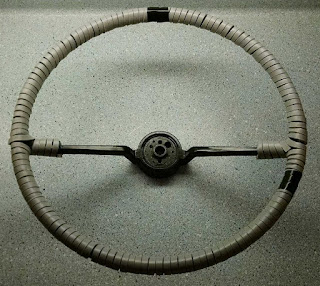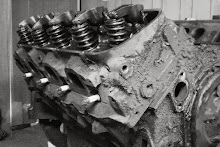The phrase "because race car" is floated around the internet to describe features and details of cars that serve no purpose other than to make the car look more like a race car. In other words, it essentially applies to my entire project. But, some features are better examples than others, and one feature that is a perfect example is the battery cutoff switch.
One day while I was working on the dashboard, I was looking at the hole where the cigarette lighter goes and trying to decide what to do with that. One option was to put a cigarette lighter in it. Another option was to leave it empty. Another option was to try to block it off somehow. I was thinking I would probably just put a cigarette lighter in it. There are a lot of electrical accessories that are designed to plug into cigarette lighters, so that might come in handy. And if nothing else, it might serve as a subtle tribute to this video of Dick Trickle smoking a cigarette in his race car during a caution.
But then, I had another idea ... I could put a battery cutoff switch in the hole for the cigarette lighter. I immediately loved the idea so much, I knew I had to do it. But, while I am more than willing to put useless race car features in my car just because they look like race car stuff, I am not willing to install stuff that isn't functional. So, it had to work.
A lot of racing sanctioning bodies require cars to have a battery cutoff switch as a safety requirement. It provides a quick way to disconnect the battery after a crash to prevent something from sparking and igniting spilled fuel, or shorting and starting an electrical fire, for example. Sometimes battery cutoff switches are required to be mounted on the outside of the car so that safety workers can use them when they arrive at the crash, other times they are mounted on the dash so that the driver can use them. For me the main purpose of the switch is to fill the hole for the cigarette lighter and to look cool, but it will also provide a quick and easy way to disconnect the battery when working on the car's electrical system.
So anyway, I ordered a cutoff switch, took some measurements to see how much battery cable I'd need, bought some battery cable, etc. I already had a hole in the dash, but it turned out to be a little bit oversized for the switch. The switch has a main body that fits into a big hole, and then there is a small post designed to fit into a smaller hole. The purpose of the post is to keep the switch from spinning in its mounting hole when someone tries to use it. I drilled a smaller hole for the post to fit into, thinking that maybe it would also serve to locate the switch body in the oversized hole for the cigarette lighter, but it was still too loose and kind of flopped around a little bit when you tried to flip the switch. It probably would have worked, but it didn't feel good.
So, I started out by making a small spacer to take up the difference between the cigarette lighter hole and the cutoff switch body. I traced the hole in the dashboard faceplate onto a piece of steel, and then traced a hole the size of the switch body onto it, and then cut out that shape. I cut it a little bit oversized and then started trimming it down, test-fitting the parts, trimming some more, test-fitting again, and so on, until everything fit.
This is the spacer I ended up with:
And this is how it looks when it's pressed into the dashboard faceplate:
The cutoff switch I got was made by Moroso, and it came with a sticker to put over the switch, to label the "off" and "on" positions. It also says "Moroso," because ... advertising.
I like the sticker because it looks official, and also because Moroso is one of the many companies who I remember seeing their names on toy race cars and photos of race cars in magazines when I was a kid. So I wanted to use the sticker, but it didn't fit in the available space on the dashboard.
I decided to make a faceplate for the switch which would install over the dashboard faceplate. The switch plate would provide a place where the sticker could be applied, and it would also sandwich the spacer in the hole in between the switch plate and the dash, so that it couldn't fall out. I traced the available space on the dash onto a piece of paper, traced the hole's location, and then traced the Moroso sticker on to that same piece of paper to see what size faceplate I could make to fit in that space. Then I cut that shape out of steel and painted it black with POR-15:
Next, I cut the "Moroso" portion of the sticker off so that I could clock it into a different orientation relative the the "OFF" and "ON" labels:
That allowed me to get the word "Moroso" into a spot where it would be visible, while also clocking the words "OFF" and "ON" into a spot where they would be visible and align with the correct switch positions. The switch faceplate ended up looking like this:
With everything assembled, it looks like this:
I think it looks pretty cool. The big lightning bolt sticker also came with the switch and is a common decal that is used to help safety workers at race tracks find the battery cutoff switch. As it came, there was more of a space between the lightning bolt and the word "OFF," so I cut that sticker and rearranged it a bit, too, in order to make it fit in the space available.
That took care of installing the switch itself, but of course it wouldn't be functional until it was wired up electrically. In the photo below, you can see the switch installed in the dash, but with the gauge pod removed. This allows you to see a couple of heavy cables that are routed from the switch straight to the firewall. They are supported at the firewall by a couple of P-clips with rubber grommets on them, and those P-clips are supported by a stud. The stud is actually one of the bolts that is holding the reservoir for the hydraulic clutch on the engine side of the firewall. It passes through the firewall, has a nut to hold the reservoir in place, then the P-clips are stacked on it, and then another nut to hold the P-clips in place.
From there, the cables run across the firewall, they are clipped in another location, then one of them runs along the top of the heater box, and the other one drops vertically down between the heater box and the firewall.
Here's the one that runs along the top of the heater box, until it passes through the firewall, through a red grommet:
And here you can just see the end of the one that drops down vertically before passing through the firewall through a black grommet:
On the engine side of the firewall, you can see the heater hoses and part of the engine, and you can also see the grommets for the battery cables to the battery cutoff switch:
Here's a close-up of the red grommet, where the battery cable passes from the battery through the firewall, on its way to the cutoff switch:
An aside on the red grommet ... I had originally bought grommets from Lowe's, I think. I had sized the inner diameters for the battery cables that would pass through them, and I didn't care about the outer diameters. The packaging listed an O.D., which I figured was the size of the hole that the grommet would fit into. Who cares about the actual O.D. of a grommet? Well, I drilled a hole for that size and ... the whole grommet fell right through the hole. I hate drilling holes in any part of the car, it's kind of stressful because you can't easily un-drill a hole. So when I realized that I had drilled too big of a hole because of my misinterpretation of the "O.D." measurement on the grommet packaging, I was pretty upset. If the person who decided how to label the "outside diameter" of that grommet had been in the garage at the time, I might have murdered them. Of course it was my own fault for not taking the time to measure the grommet before I drilled the hole, but that hardly seemed relevant at the time. Anyway, McMaster-Carr has a fantastic website that is extremely searchable, with very clearly labeled dimensions for all their parts, and I was able to find a couple grommets with the correct I.D., correct O.D. to match the hole I'd drilled, correct thickness, etc. One of them was only available in quantities of 50, or something like that, and the other one was only available in a high temp material, but could be had in quantities as small as 5. That one happened to also be red, and that's the one I ordered.
Anyway, in the middle of this next photo, you can make out the black grommet where a cable passes from the cutoff switch back through the firewall, and up to the back of the engine, where it is grounded using one of the flywheel housing bolts:
The photo below shows the negative battery cable running from the battery post along the top of the inner fender and back to the firewall, where it passes through its grommet, and into the car.
And the next photo was taken from under the car, looking up to show where the cable then passes back through the firewall and bolts to the engine using one of the bellhousing mounting bolts.
To make the cables, I bought lengths of cable at O'Reilly's, cut them to length, and added terminals. For the terminals that clamp to the battery posts, I got a couple that attach to the battery cables with clamps that are bolted on. For the terminals that bolt to the switch posts and the engine, I got copper lugs that are soldered on. The soldering process for these large lugs is pretty cool. You strip off the insulation from the end of the battery cable, and dip the exposed cable in solder flux. Then you stick that exposed end of the cable into the lug, and use a hammer and punch to roughly crimp the lug onto the cable. Then the last step is to heat the lug with a torch until it is hot enough to melt solder, and you just feed solder into the joint until the lug is full of solder. Then a piece of heat shrink insulation over the end of the lug finishes the job.
I decided to run the battery ground to the cutoff switch because ... well, I don't remember why. I think part of it was because, if a battery cable somehow chafed through its insulation and through the grommet in the firewall, a ground cable grounded to the firewall would just mean that the cutoff switch would no longer work, as opposed to a positive cable grounded to the firewall, which could start a fire. Some people put the switch on the positive cable, but some people put it on the ground and that seemed safer and easier to me, so that's what I did.
Anyway, the arrangement seems to work, in the sense the it works to connect the battery, it works to disconnect the battery, and it works to look awesome. I'm pretty happy with how it turned out.

























































